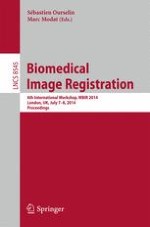This book constitutes the refereed proceedings of the 6th International Workshop on Biomedical Image Registration, WBIR 2014, held in London, UK, in July 2014.
The 16 full papers and 8 poster papers included in this volume were carefully reviewed and selected from numerous submitted papers. The full papers are organized in the following topical sections: computational efficiency, model based regularisation, optimisation, reconstruction, interventional application and application specific measures of similarity.
